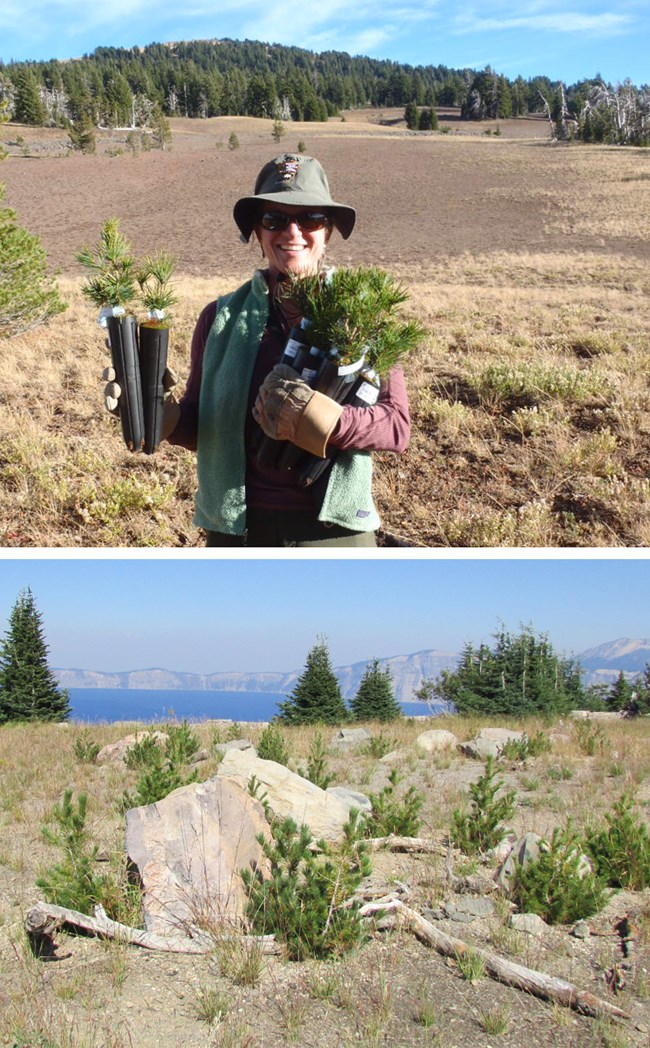Last updated: April 19, 2023
Article
Boosting Natural Selection: A Conservation Tool for the Whitebark Pine

USFS/R. Sniezko
In Cottage Grove, Oregon, a giant garden sprouting rows of green and brown tree seedlings is part of an ongoing genetic experiment. Researchers at the US Forest Service’s Dorena Genetic Resource Center are methodically searching for whitebark pine (Pinus albicaulis) seedlings showing natural resistance to a major fungal disease, white pine blister rust. Their success could play an important role in conserving this keystone species. Some Western parks with whitebark pine habitat, including Crater Lake National Park, are pitching in to help.

NPS
The iconic whitebark pine thrives in harsh subalpine climates, feeding wildlife with the nutritious seeds in its cones, stabilizing the thin rocky soil with its roots, and prolonging snowmelt with its shade. But white pine blister rust, a disease caused by the nonnative fungal pathogen, Cronartium ribicola, and mortality caused by the mountain pine beetle have taken a toll on these trees. Declines have been so severe that in 2011 the US Fish and Wildlife Service declared it a candidate for listing under the Endangered Species Act. A final decision is expected in 2019. [Update: US Fish and Wildlife Service listed the whitebark pine as Threatened on January 17, 2023]. In response, federal agencies, university scientists, and conservation organizations have been taking a multipronged conservation approach:
- Research the tree’s ecology, genetics—including natural rust resistance—and vulnerability to different stressors.
- Monitor the status of whitebark pine, along with the presence of white pine blister rust and mountain pine beetles across the tree’s range, to keep track of the spread of these threats and their impacts.
- Protect existing stands through direct action and by maintaining genetic diversity. Some direct action examples are placing pheromones on trees to prevent mountain pine beetle attack, clearing debris from tree understories to reduce fire risk, and pruning branches of trees with blister rust cankers.
- Restore whitebark pine by planting rust-resistant seedlings in targeted locations, as well as promoting natural ecological processes, such as wildland fire, which creates openings for seedling regeneration, among other benefits.

NPS
The Dorena Genetic Resource Center began researching the effects of white pine blister rust on five-needle pines 50 years ago, in 1966. The focus on whitebark pine, however, began in 2002 and has progressed to planting rust-resistant trees in a handful of parks and national forests. Crater Lake National Park staff got on board with the initial trials and began sending cones from healthy, older trees for testing at Dorena in 2003. The entire process from start to finish is costly ($1000/tree, not including cone collection) and complex, but provides new stock that will hopefully withstand blister rust attack. Identifying rust-resistant individuals takes up to seven years:
- In rust-infected areas, identify healthy whitebark pine trees with no sign of blister rust—these are the individuals most likely to have some genetic resistance to the disease.
- Protect these individuals using a mountain pine beetle pheromone—verbenone—to stave off beetle attack. The pheromone says, “This tree is already full of beetles – go somewhere else!”
- Cage the developing cones in midsummer from hungry Clark’s nutcrackers.
- In early October, remove the cages, harvest the cones, extract the seeds and grow them at Dorena.
- At two-years-old, infect the seedlings with blister rust and monitor for five more years to identify which are most resistant—this often leaves just a small percentage of the original batch alive.
- Plant the most rust-resistant survivors (graded from A to F for degree of resistance) in areas targeted for recovery. As of 2016, 87% of seedlings planted at the Rim Village parking area in Crater Lake have survived so far—in part due to the lack of hungry gophers in the area! [Update: as of 2022, 75.9% of the seedlings have survived.]

NPS
While the Dorena Genetic Resource Center handles research and development, and Crater Lake staff work on protecting and restoring rust-resistant trees, the Klamath Network contributes to the overall conservation strategy through its long term monitoring program. Whitebark pine are one of the Network’s “vital signs” of park health. Every summer, Klamath Network botanist, Sean Smith, works with an intern from our host campus, Southern Oregon University, to monitor the status of whitebark pines at Crater Lake and Lassen Volcanic National Parks. They count seedlings, measure diameters, document dead trees, and record evidence of blister rust and mountain pine beetles. Some of this information feeds a regional dataset housed by the US Forest Service that can be shared with cooperators. More locally, however, it supplies Crater Lake and Lassen Volcanic park scientists with a regular checkup on this vital sign of montane ecosystem health.
Learn more about whitebark pine conservation in the West:
Dorena Genetic Resource Center
Whitebark Pine Ecosystem Foundation
Whitebark Pine Restoration at Crater Lake National Park
Klamath Network Whitebark Pine Monitoring Program
Article by Sonya Daw, Klamath Inventory and Monitoring Network
Adapted from The Klamath Kaleidoscope newsletter, Fall-Winter 2017 issue, updated 1-3-2023
